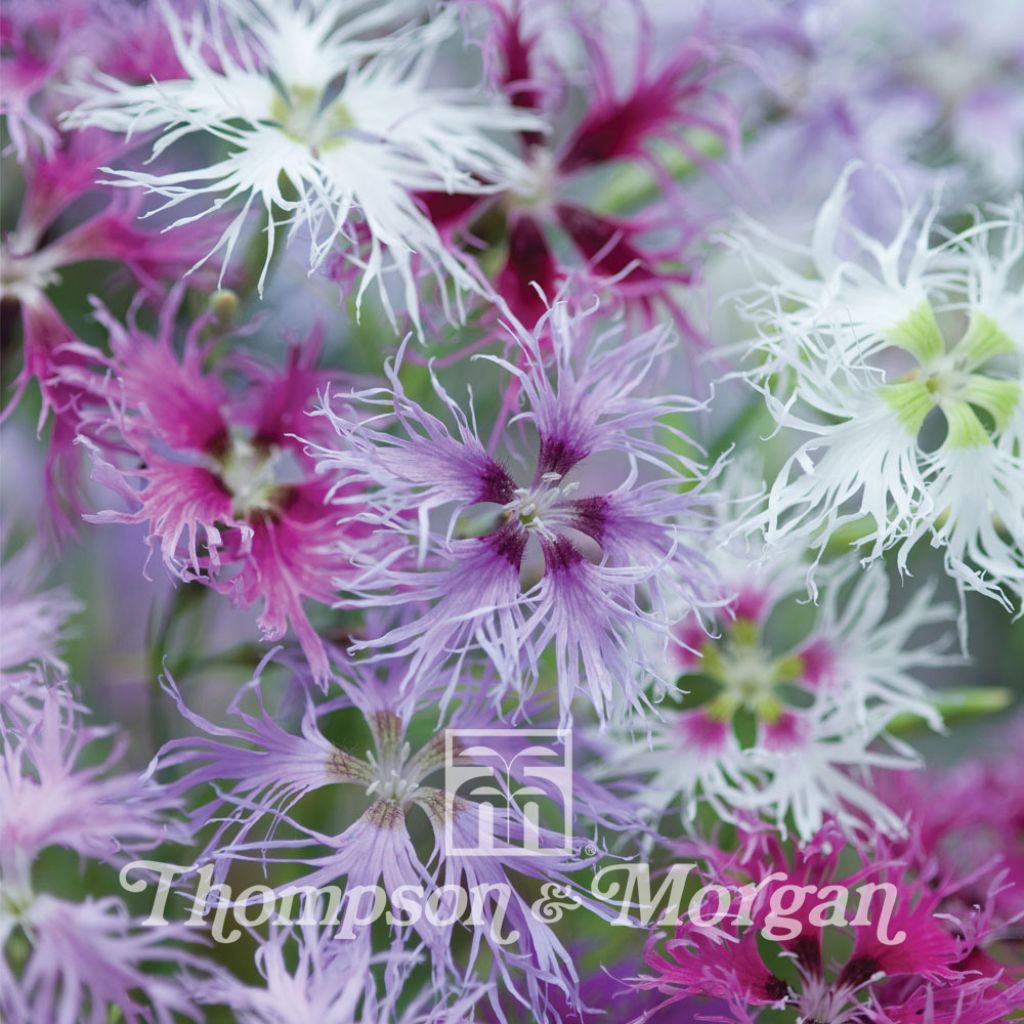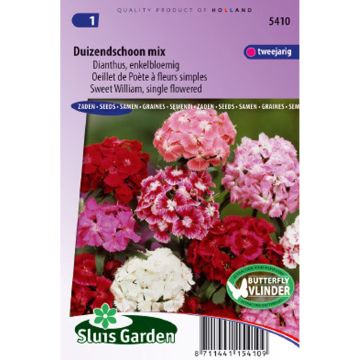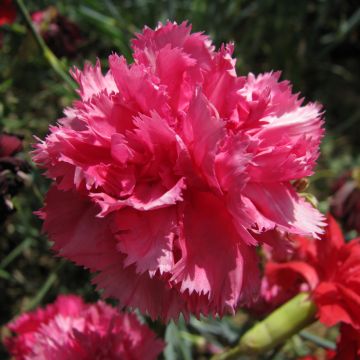

Dianthus Rainbow Loveliness Improved Mixed
Dianthus Rainbow Loveliness Improved Mixed - Garden Pink seeds
Dianthus hybrid Rainbow Loveliness Improved Mixed
Hybrid Pink, Garden Pink
Low germination rate. One of the plants produced flowers with "atrophyed" petals.
Virginie V., 14/08/2017
Why not try an alternative variety in stock?
View all →This plant carries a 6 months recovery warranty
More information
We guarantee the quality of our plants for a full growing cycle, and will replace at our expense any plant that fails to recover under normal climatic and planting conditions.
Seed-only orders are dispatched by sealed envelope. The delivery charge for seed-only orders is €3.90.
Does this plant fit my garden?
Set up your Plantfit profile →
Description
Dianthus Rainbow Loveliness Improved Mix presents an airy flowering of tousled and finely cut, rainbow-coloured flowers with a sweet perfume. They are the fabulous and very perennial, almost perfect result of extensive research. These compact and robust plants will quickly form fluffy tufts in pastel or red colours from the first year, if sown in February. Ideal in borders, pots and summer bouquets, they are easy to grow in moist, well-drained soil, in the sun.
The carnations of the Rainbow Loveliness Improved Mixed selection belong to the Caryophyllaceae family, their ancestry is multiple and complex, but they have inherited the intensely cut and fringed petals of the alpine species Dianthus superbus. They are as easy to grow as garden carnations, appreciating the same sunny environment and well-drained soils. These perennial and compact plants form basal tufts adorned with fine, evergreen, glaucous green foliage. Their rapid growth allows them to produce flowers a few months after sowing. When in bloom, they will not exceed 30 cm (12in) in all directions. Flowering takes place from July to September with surprisingly delicate flowers, with fine, tousled, finely incised petals, forming perfumed clouds in an infinite range of shades: they are white, pink, lilac, mauve, carmine red and all shades in between, with solid or bicoloured flowers. Their scent is spicy and sweet, reminiscent of cloves and cinnamon.
The Rainbow Loveliness Improved Mixed carnation is an easy plant to grow that needs minimal maintenance once well established. Like love-in-a-mist, bellflowers, and columbines, these charming plants have a place in all gardens. Choose an area along a path or near an entrance, to fully enjoy the sweetness of the plants' fragrance. In flower beds, plant the carnations en masse in the foreground, to create beautiful carpets. They can also be grown in pots on the terrace or balcony, with good drainage and fertiliser.
Report an error about the product description
Flowering
Foliage
Plant habit
Botanical data
Dianthus
hybrid
Rainbow Loveliness Improved Mixed
Caryophyllaceae
Hybrid Pink, Garden Pink
Cultivar or hybrid
Other Dianthus seeds
Planting and care
Sow these seeds from February to April.
Sow in well-drained trays, containers, or pots filled with a special seed compost. The seeds should be barely covered with compost. Place the seedlings in a propagator, a mini-greenhouse, or a warm location to maintain an optimal temperature of 18 to 20°C (64.4 to 68°F). Germination usually takes 14 to 30 days. Do not exclude light, as this promotes germination. Keep the surface of the compost moist, but not waterlogged.
Transplant the young plants when they are large enough to handle, into individual pots with a diameter of 8 cm (3in). Gradually acclimatise the young plants to outdoor conditions. Plant them with 23 cm (9in) between each plant, once all risk of frost has passed.
Cultivation:
Plant the young carnations in ordinary, permeable, humus-rich, preferably chalky, dry to moist, and well-drained soil. A gravel-rich soil yields good results. In the open ground, this plant is quite hardy, withstanding temperatures down to -15°C (5°F). It prefers a very sunny exposure. Prune the clump lightly after summer flowering to encourage a second flowering in September. In rich soil, trim part of the foliage with shears after flowering to maintain a dense habit. In poor soil, it is a good idea to apply a balanced fertiliser in March. It is also helpful to divide the clumps every 3 years to rejuvenate those with thinning bases and you can easily propagate them through layering or cuttings.
Sowing period
Intended location
-
, onOrder confirmed
Reply from on Promesse de fleurs
Flower seeds
Haven't found what you were looking for?
Hardiness is the lowest winter temperature a plant can endure without suffering serious damage or even dying. However, hardiness is affected by location (a sheltered area, such as a patio), protection (winter cover) and soil type (hardiness is improved by well-drained soil).

Photo Sharing Terms & Conditions
In order to encourage gardeners to interact and share their experiences, Promesse de fleurs offers various media enabling content to be uploaded onto its Site - in particular via the ‘Photo sharing’ module.
The User agrees to refrain from:
- Posting any content that is illegal, prejudicial, insulting, racist, inciteful to hatred, revisionist, contrary to public decency, that infringes on privacy or on the privacy rights of third parties, in particular the publicity rights of persons and goods, intellectual property rights, or the right to privacy.
- Submitting content on behalf of a third party;
- Impersonate the identity of a third party and/or publish any personal information about a third party;
In general, the User undertakes to refrain from any unethical behaviour.
All Content (in particular text, comments, files, images, photos, videos, creative works, etc.), which may be subject to property or intellectual property rights, image or other private rights, shall remain the property of the User, subject to the limited rights granted by the terms of the licence granted by Promesse de fleurs as stated below. Users are at liberty to publish or not to publish such Content on the Site, notably via the ‘Photo Sharing’ facility, and accept that this Content shall be made public and freely accessible, notably on the Internet.
Users further acknowledge, undertake to have ,and guarantee that they hold all necessary rights and permissions to publish such material on the Site, in particular with regard to the legislation in force pertaining to any privacy, property, intellectual property, image, or contractual rights, or rights of any other nature. By publishing such Content on the Site, Users acknowledge accepting full liability as publishers of the Content within the meaning of the law, and grant Promesse de fleurs, free of charge, an inclusive, worldwide licence for the said Content for the entire duration of its publication, including all reproduction, representation, up/downloading, displaying, performing, transmission, and storage rights.
Users also grant permission for their name to be linked to the Content and accept that this link may not always be made available.
By engaging in posting material, Users consent to their Content becoming automatically accessible on the Internet, in particular on other sites and/or blogs and/or web pages of the Promesse de fleurs site, including in particular social pages and the Promesse de fleurs catalogue.
Users may secure the removal of entrusted content free of charge by issuing a simple request via our contact form.
The flowering period indicated on our website applies to countries and regions located in USDA zone 8 (France, the United Kingdom, Ireland, the Netherlands, etc.)
It will vary according to where you live:
- In zones 9 to 10 (Italy, Spain, Greece, etc.), flowering will occur about 2 to 4 weeks earlier.
- In zones 6 to 7 (Germany, Poland, Slovenia, and lower mountainous regions), flowering will be delayed by 2 to 3 weeks.
- In zone 5 (Central Europe, Scandinavia), blooming will be delayed by 3 to 5 weeks.
In temperate climates, pruning of spring-flowering shrubs (forsythia, spireas, etc.) should be done just after flowering.
Pruning of summer-flowering shrubs (Indian Lilac, Perovskia, etc.) can be done in winter or spring.
In cold regions as well as with frost-sensitive plants, avoid pruning too early when severe frosts may still occur.
The planting period indicated on our website applies to countries and regions located in USDA zone 8 (France, United Kingdom, Ireland, Netherlands).
It will vary according to where you live:
- In Mediterranean zones (Marseille, Madrid, Milan, etc.), autumn and winter are the best planting periods.
- In continental zones (Strasbourg, Munich, Vienna, etc.), delay planting by 2 to 3 weeks in spring and bring it forward by 2 to 4 weeks in autumn.
- In mountainous regions (the Alps, Pyrenees, Carpathians, etc.), it is best to plant in late spring (May-June) or late summer (August-September).
The harvesting period indicated on our website applies to countries and regions in USDA zone 8 (France, England, Ireland, the Netherlands).
In colder areas (Scandinavia, Poland, Austria...) fruit and vegetable harvests are likely to be delayed by 3-4 weeks.
In warmer areas (Italy, Spain, Greece, etc.), harvesting will probably take place earlier, depending on weather conditions.
The sowing periods indicated on our website apply to countries and regions within USDA Zone 8 (France, UK, Ireland, Netherlands).
In colder areas (Scandinavia, Poland, Austria...), delay any outdoor sowing by 3-4 weeks, or sow under glass.
In warmer climes (Italy, Spain, Greece, etc.), bring outdoor sowing forward by a few weeks.
































































